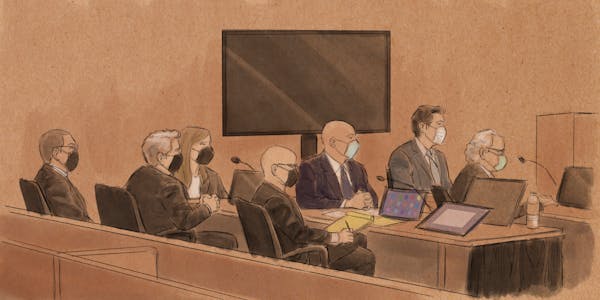On the seventh day of the federal civil rights trial of three former Minneapolis police officers Tuesday in St. Paul, the Hennepin County chief medical examiner testified about the factors contributing to George Floyd's death and the defense asked whether threats influenced his report.
Dr. Andrew Baker said in cross examination by Tou Thao's attorney Robert Paule that he and his office became targets of protests after County Attorney Mike Freeman published his preliminary autopsy findings days after Floyd's death. Freeman included the results in the charges against former officer Derek Chauvin and highlighted Floyd's cardiovascular disease and "potential intoxicants" in his body.
Baker testified that his office phone rang "off-the-hook around-the-clock" with threatening messages about his work on the case in the chaotic as protests and riots erupted in the days after Floyd's death.
Baker said some of the threats targeted specific employees, their families and included home addresses.
But he said his conclusions on Floyd's death report were neither partisan nor driven by outside pressure.
Baker, who also serves as chief medical examiner for Dakota and Scott counties, told jurors Monday afternoon that Floyd died when his heart and lungs stopped because of the restraint by law enforcement.
"I view his death as being multifactorial," he said, attributing it to the duration of his "interaction with law enforcement" for 9½ minutes along with his already enlarged heart and hardened arteries. He said the combination of factors was more than Floyd's body could take.
Baker ruled out other factors, including the fentanyl and methamphetamine found in Floyd's body as well as carbon monoxide poisoning.
Thao, J. Alexander Kueng and Thomas Lane are charged with failing to provide aid to Floyd. Thao and Kueng are also charged with depriving Floyd of his right to be free from unreasonable search and seizure.
The three former officers also face trial in June in Hennepin County District Court on charges related to Floyd's death.
Chauvin was convicted of murder in 2021 and later pleaded guilty in federal court to a civil rights charge.
Paule questioned Baker the longest time. He did not accuse him of bias but asked about outside pressure the forensic pathologist faced from activists and other medical experts in the days and weeks after Floyd's death.
Baker replied "no" when asked whether anyone in government or at the Minneapolis Police Department urged him to say anything other than the truth.
It was the same answer he gave in previous grand jury testimony discussed in court.
Paule also asked whether Floyd's underlying heart conditions could have led to a "cardiac event" before he was restrained under Chauvin's knee. "It's possible, but there's no way to know," Baker said.
Baker said Floyd's combination of arteriosclerotic heart disease and hypertension "would put your heart in position for deleterious things to happen if your heart was stressed."
Paule asked Baker about excited delirium as a possible cause of death. In his 24 years as a medical examiner, Baker said, he's used the term a "handful of times," but he did not cite the condition as a cause on Floyd's death certificate.
When Kueng's attorney Thomas Plunkett questioned Baker, he posted an image of Floyd being restrained. Plunkett noted the location of Kueng's knee on Floyd's waist or buttocks, but Baker said he thought the knee was lower, on the back of Floyd's thigh, and that the position "wouldn't impair his ability to breathe."
When attorney Earl Gray questioned Baker on behalf of Lane, he asked a similar question about his client holding down Floyd's legs and feet. Baker said he found that position "completely unrelated to Mr. Floyd's ability to breathe."
The only other witness Tuesday was Christopher Douglas from Hennepin County's Department of Community Corrections. Douglas is the lead safety trainer for the county's Juvenile Detention Center, where Lane worked before joining the Police Department.
He testified about the training he gives on positional asphyxia that Lane would have taken while working in the detention center in 2017 and 2018.
With Douglas on the stand, Assistant U.S. Attorney Samantha Trepel posted images from training presentations. Among the lessons were how to "get control of the subject quickly," using arms instead of body weight and avoiding putting pressure on the torso and neck "if possible," Douglas testified while reading from the slides.
Other slides showed that restrained subjects should be monitored for medical issues even after they're put on their side or are sitting up in a recovery position and that warning signs of trouble include "a person saying they can't breathe," he said.
Testimony resumes Wednesday.
Star Tribune staff writer Chao Xiong contributed to this report.
Carolyn Parnell, 'trailblazer' who served as Minnesota's first IT commissioner, dies


